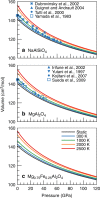Velocity and density characteristics of subducted oceanic crust and the origin of lower-mantle heterogeneities
- PMID: 31911578
- PMCID: PMC6946644
- DOI: 10.1038/s41467-019-13720-2
Velocity and density characteristics of subducted oceanic crust and the origin of lower-mantle heterogeneities
Erratum in
-
Author Correction: Velocity and density characteristics of subducted oceanic crust and the origin of lower-mantle heterogeneities.Nat Commun. 2020 May 4;11(1):2247. doi: 10.1038/s41467-020-16195-8. Nat Commun. 2020. PMID: 32366849 Free PMC article.
Abstract
Seismic heterogeneities detected in the lower mantle were proposed to be related to subducted oceanic crust. However, the velocity and density of subducted oceanic crust at lower-mantle conditions remain unknown. Here, we report ab initio results for the elastic properties of calcium ferrite-type phases and determine the velocities and density of oceanic crust along different mantle geotherms. We find that the subducted oceanic crust shows a large negative shear velocity anomaly at the phase boundary between stishovite and CaCl2-type silica, which is highly consistent with the feature of mid-mantle scatterers. After this phase transition in silica, subducted oceanic crust will be visible as high-velocity heterogeneities as imaged by seismic tomography. This study suggests that the presence of subducted oceanic crust could provide good explanations for some lower-mantle seismic heterogeneities with different length scales except large low shear velocity provinces (LLSVPs).
Conflict of interest statement
The authors declare no competing interests.
Figures





References
-
- Tackley, P. J. in Treatise on Geophysics 521–585 (Elsevier, 2015).
-
- Ritsema J, Ni S, Helmberger DV, Crotwell HP. Evidence for strong shear velocity reductions and velocity gradients in the lower mantle beneath Africa. Geophys. Res. Lett. 1998;25:4245–4248. doi: 10.1029/1998GL900127. - DOI
-
- Thorne MS, Garnero EJ. Inferences on ultralow-velocity zone structure from a global analysis of SPdKS waves. J. Geophys. Res. Solid Earth. 2004;109:1–22. doi: 10.1029/2004JB003010. - DOI
LinkOut - more resources
Full Text Sources

